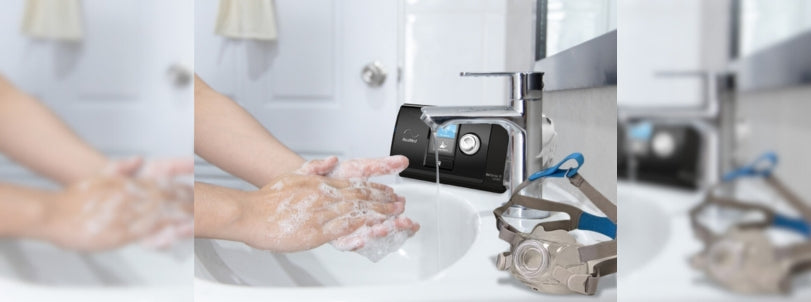
Do You Need to Wash New CPAP Supplies?
Regularly replacing CPAP supplies is important in effectively treating obstructive sleep apnea. It is equally imperative to regularly clean CPAP parts including the mask cushion, tubing, headgear, and humidifier chamber.
Cleaning your CPAP equipment removes mold, bacteria, and dust that could cause illness or infection. Aside from hygiene, regular cleaning of the mask cushion ensures the integrity of the all-important seal. This helps keep the airways open by preventing leakage of air from the mask.
However, you may be wondering if you need to wash new CPAP supplies, given that they have never been used.
Provided you receive your new CPAP supplies from reputable sources, they should arrive sealed from a sterile environment. You may feel the need to wash new CPAP supplies for peace of mind to ensure that they are clean and hygienic to use from the start, but you can rest assured your items have arrived completely sanitized.
Another reason you may feel you need to wash new CPAP supplies is due to the smell of plastic packaging that can accompany new items. If this is something that typically bothers you, you may be more comfortable washing your items before use.
How to Wash New CPAP Supplies
If, for whatever reason, you decide you do need to wash your new CPAP supplies before use, the process is quick and simple. Familiarizing yourself with this process is good practice too, as daily cleaning of the mask cushion and humidifier chamber is important for effective and hygienic CPAP treatment.
- CPAP mask cushion, frame, and headgear: Wash in a sink or tub using warm, drinking-quality water and a mild dishwashing detergent. Rinse thoroughly and allow to air dry on a towel placed on a flat surface.
- CPAP tubing: Use a mild dishwashing detergent and warm, drinking-quality water to rinse the tubing inside and out. Rinse thoroughly and air dry on a towel placed on a flat surface.
- Humidifier chamber: Wipe around thoroughly with a clean, disposable cloth before allowing it to air dry away from direct sunlight.
From thereon, CPAP parts require a daily or weekly clean. Cleaning CPAP supplies only takes five minutes of your time, but is important in preventing the return of your obstructive sleep apnea symptoms.
How Often Should You Clean CPAP Parts?
Cleaning CPAP equipment can quickly become part of your daily and weekly routine.
For just five minutes every day, you can keep your CPAP mask cushion clean and preserve the integrity of its seal against your skin. When the seal is compromised, air leaks mean less air is delivered to keep the airways clear and you could see the return of your obstructive sleep apnea symptoms.
CPAP parts should be cleaned on the following basis:
- Daily: Wash CPAP mask cushion. Empty distilled water from the humidifier chamber and wipe clean.
- Weekly: Wash CPAP tubing, mask frame and headgear. Soak humidifier chamber.
When cleaning, first unplug the CPAP device from the power outlet.
To clean the different elements of the mask you will need to disconnect them from the tubing before disassembling them into their constituent parts. The mild detergent cleans away oils from the skin deposited on the mask cushion which can affect the integrity of the seal.
The tubing also needs disconnecting from the CPAP device before cleaning. Without daily cleaning, mold and germs can form in the tubing.
It is important to empty the distilled water from the humidifier daily. If you leave the water in the chamber for a prolonged period, you risk a build-up of bacteria.
As well as a daily wipe down of the empty humidifier chamber, a soak every week in warm water containing a mild dishwasher detergent will also help keep it clean. Rinse the chamber thoroughly with warm drinking-quality water before allowing it to air dry on a towel placed on a flat surface. Keep the chamber out of direct sunlight.
What Not to Use When Washing New CPAP Supplies
Using warm water and a mild dishwashing detergent is recommended, as it is kinder on the materials used in manufacturing CPAP supplies.
When you are considering what you need to wash new CPAP supplies, you should read the recommended manufacturer guidelines on cleaning, how often, and when to replace the various parts.
Certain products should not be used for cleaning as they could damage the CPAP mask and threaten the effectiveness of the treatment. This could also lead to experiencing skin irritation that could threaten your compliance with CPAP.
Products to avoid include:
- bleach
- alcohol
- antibacterial soaps
- scented oils
- dish soap
You will also want to avoid any temptation to put your CPAP supplies into the washing device or dryer. Although this may seem like a convenient option, it could damage the parts and require them to be replaced earlier than would otherwise be necessary.
How Often Do You Need New CPAP Supplies
CPAP supplies need regular replacement to maintain the best treatment for obstructive sleep apnea. You should check the manufacturer’s recommendation for when CPAP parts need replacing, but the following provides a guideline.
1. Parts to replace every month:
- CPAP mask cushion
- Air filters
2. Parts to replace every three months:
- CPAP mask frame
- CPAP tubing
3. Parts to replace every six months
- CPAP mask headgear
- Humidifier chamber
The lifespan of a CPAP device can be up to five years before it needs replacing. The device may feel like it’s still working fine, but you could benefit from the latest devices offering the most recent, innovative technology.
Regular cleaning of CPAP equipment helps keep your airways clear of obstruction to improve your vital restorative sleep. It also makes for a more hygienic treatment, free from illness caused by lingering bacteria and mold, while prolonging the lifespan of your CPAP supplies.
